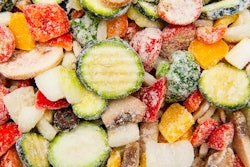
The pandemic of 2020 upended countless rituals for both consumers and operations leaders alike. From paper towels to plumbing supplies, the public and businesses struggled to address shortages in their lives and in their delivery systems. But, contrary to common perception, not all supply chains struggled to meet demand. Some, such as perishable consumer packaged goods (CPG), excelled because they were well positioned to respond to the unique challenges posed by the pandemic.
One certain byproduct of the Coronavirus disease (COVID-19) was the introduction of the term “supply chain” into the public’s vocabulary. Consumers who previously had little to no understanding of supply chains – and who probably took for granted how everyday consumables reached store shelves – became intimately aware of the importance of a strong supply chain. Whether it was product that couldn’t be secured for a home improvement project or slim offerings in the meat case at the grocery store, consumers across the nation felt the pain when supply chains became disrupted.
But, for operations professionals, the lessons of the pandemic were even more critical. Though some consider the pandemic to have been an unforeseen crisis – possibly even a “black swan” event – it presented a unique opportunity to evaluate the resiliency of different supply chain models. Rarely is the operations industry presented with a supply chain “laboratory” in the form of a stressed environment with volatile demand fluctuations as well as infrastructure challenges.
It might surprise operations professionals that some supply chains excelled at the consumer “eye test,” where product was consistently found on the shelf day after day. After all, a true measure of a supply chain is having product on shelf, in good condition and at the consumer’s desired point of sale.
The best supply chains in the world have long been viewed as those that make Gartner’s “Top 25 Supply Chains.” These “purebred” supply chains today capture what has been in vogue for some time now – scaled, highly efficient, make-to-stock inventory models with leading edge technology and systems infrastructure.
Many of these world-class supply chains operate in industries generally unconstrained by short product shelf life or expiration dates. This enables these companies to have large, globally dispersed supply chains achieving lowest landed cost objectives by leveraging multiple source countries.
Conversely, short shelf life, perishable product industries – such as fresh baked goods, dairy and produce – generally don’t have the luxury of building large, finished goods inventory. As such, their supply chains generally have embedded excess capacity to handle large fluctuations in daily demand with several manufacturing plants very close to major population centers. Couple this with a high-cost, direct-store delivery (DSD) system to service customers daily, and it’s easy to understand why companies have exited this model in favor of the warehouse model. This might explain why there is not one perishable or short shelf-life CPG company in the top list.
However, it is precisely these perceived weaknesses in perishable DSD supply chains that became strengths during the pandemic. Domestic near-shore sourcing, often a necessity for short shelf-life products, became an advantage. It enabled CPG manufacturers to avoid supply chain disruptions such as port closures, border shutdowns and varying country-specific COVID-19 restrictions.
Proximity to markets, available capacity, very short order cycles and scaled DSD fleets enabled perishable supply chains to be flexible, resilient and responsive. Customers consistently found daily replenishment of baked goods shelves in neighborhood grocery stores. Contrast this with the negative impacts of the “bull whip effect” often experienced by inventory-based supply chains during material demand spikes; consumers might find stock on the shelf one day, but an empty shelf the next.
Perishable goods supply chains didn’t just excel in keeping shelves stocked. They also delivered on sustainability and solid waste stream usage. While many durable goods and warehouse CPG goods utilize corrugated packaging for shipment of finished goods, DSD (especially perishable categories) typically utilizes re-usable plastic baskets and crates – many made with recycled plastics – to ship product. This is a considerable advantage, especially considering circular economies and how the significant increase in last-mile delivery to consumers’ homes this past year – especially in non-food durable goods – has driven corrugated waste to levels never before seen.
It might be too much to hope that a perishable CPG company breaks into Gartner’s “Top 25 Supply Chains.” But, the pandemic surely shined a spotlight on a frequently overlooked supply chain that did not find itself in the news last year, precisely because customers had no trouble finding bread and other baked goods on their store shelves during lockdown.



















